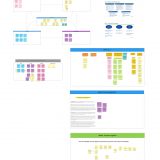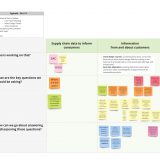Project Avant-Garde
This is the story of how 7 forward-looking companies and 30 pioneering individuals with a shared passion developed innovative, practical concepts that could transform the fashion and retail industry.
Participating companies: DHL, H&M, Mastercard, Ralph Lauren, Standard Chartered, Unibail-Rodamco-Westfield, Zalando
01
Reinventing the business of fashion
Why we need new recipes for the industry
Despite years of investment in sustainability, the fashion and retail value chain is brittle and ill-prepared to address the existential challenges facing our planet. The Covid crisis has made this all too clear. Making progress on ambitions like reducing carbon emissions or building circular value chains will require new and unconventional business approaches.
That’s why in May 2021, Helena Helmerson (CEO of H&M) gave us the challenge to reinvent the fashion industry by forming new, unconventional partnerships to reimagine the entire value chain. Our mandate: create new recipes for the industry. This was the start to an exciting, challenging and unpredictable journey.
Scroll down to continue
Other Resources
02
Innovation process
2.1 Recruiting the chefs
With direction from Helena, we set out to identify partners to help on this journey. We used the metaphor of a kitchen: How can we cook new dishes with different ingredients? Which chefs do we need for this? And what kind of mindset do they need to bring with them to create something new and tasty? Seven brave companies were not only willing to send us their chefs, but also to fund the kitchen space and ingredients.
Innovation among these unconventional peers could only work when participants were confident that their interests were aligned, and diverse capabilities were complimentary. In two meetings in June 2021, before diving into content, we took time to understand who was in the kitchen and what they brought with them. Each cook shared their company’s strategic intent, their company’s unique “superpowers” and their own personal motivation for joining the project. These leaders formed the Core Team which oversaw the various design teams that later got down to the hard work in the kitchen. The Core Team’s job was to make sure that the emerging menu of new dishes was relevant and coherent, and that the company’s best minds were brought to the kitchen.
Scroll down to continue
02
Innovation process
2.2 How to create new dishes? A focused innovation agenda and a structured process
Cooking requires some preparation and structure, especially when experimenting with new combinations of ingredients. To create new dishes for the industry, we collectively crafted an innovation agenda. And, because innovation is inherently messy, OXYGY created a virtual kitchen and a clear process to contain the messiness.
The Core Team was explicit early on that our process should not rehash work already done well by others, should be business-focused, and should lead to concrete implementable ideas that could be taken commercially to scale. A textbook approach to innovation might start with research and a detailed scan of trends in the sector. With this group of senior executives, we fast-forwarded straight to their insights about the ways of working in the industry that once worked but that now were holding us back. In our first meetings with the Core Team we generated a long list of paradigms – conventional ideas and assumptions that are holding us back – and let our imagination run with “what if” scenarios of what could be possible if we could break those paradigms. This early scan led to an initial innovation agenda in June 2021, comprised of four key focus areas. We defined a 100-day timeline that would take the innovation agenda from paradigm busting, to “what if” imagining, to ideation. Our goal was a menu of concepts that had potential to be both transformative and commercially interesting.
Scroll down to continue
02
Innovation process
2.3 Welcome to the Kitchen: creating structure to hold the chaos
Innovation in business is just like developing new recipes. You combine different ingredients and cooking styles to find both complementarity and novelty. The process involves trial and error. Some routes lead to exciting new discoveries, others to dead ends. The process is messy but can be managed with a disciplined approach.
It’s remarkable that we’ve been able to bring our chefs together for an extended period of time, thanks to a combination of technology and the new mentality of online and remote work, normalized by the Covid pandemic.
We developed a virtual kitchen in Miro which quickly became a lively experimentation field where the teams documented their work progress and met regularly.
Scroll down to continue
Our Process
Interviews
Coming soon.
03
New concepts
3.1 Busting Paradigms to create an innovation agenda
We selected the paradigms that were most widely held in the industry and whose impact, if busted, would be most transformational to improve resilience of the industry. Busting the paradigms meant imagining “what if” they were flipped, undone, fundamentally changed. This led to an innovation agenda of four inspiring “what if’s”. With this starting point set, the Core Team identified colleagues to form the teams that would dive deep into this work. The 100-day sprint was ready to begin in earnest.
Scroll down to continue
03
New concepts
3.2 Trusted Ecosystem
The ways of working between brands, suppliers, and banks which brought us to 2020 will not bring us to where we need to be in 2030. While some brands have taken on the ambitious challenges of decarbonizing the industry, the sector is on track to miss the 2030 targets for decarbonizing by 50%—with severe financial consequences and damage to reputations and consumer trust.
The fashion industry is highly disaggregated with many thousands of manufacturers working 1-to-1 with thousands of brands large and small. Contracts are short-term between buyers and sellers, while the investment needs for a sustainable future are long-term and underfunded. What if we create a new way of working that shifts from 1:1, short-term and non-transparent to many-to-many, longer-term and transparency that builds trust? The story is told in this document.
Scroll down to continue
03
New concepts
3.3 Circular Shopping Environment
Fashion is traditionally one-way: transform raw materials into garments, sell them to consumers, and then they throw them away. A sustainable future will require us to figure out economically viable models for prolonging the life of garments. Circularity is high on the agenda of the industry and there are many small initiatives, but consumers are not yet engaged. What if the shopping environment could become a fully integrated part of a circular logistics network and provide better consumer experience? What if consumers could be integral participants in a circular economy rather than simply buyers? What if we could create an omnichannel experience that attracts, excites and engages customers in circularity and prolongs the life of garments? The story is told in this document.
Scroll down to continue
03
New concepts
3.4 Data & Consumer - The redeployed design teams
“Fail often, fail fast” is a common saying in the start-up world, but it can also apply to cooking. While two design teams were able to make progress fast, we soon realized that the other two were not quite as productive as standalone streams. We had set out to bust the paradigm that data is incomplete, incompatible, and not shared: what if it was? And we had set out to bust the paradigm that consumer behavior does not follow sentiment: what if we could share data that would unlock better responsiveness of the value chain to consumer demand for sustainability?
When we looked at “pulling” better data through the value chain to better inform consumers, we saw that others were working on this—such as the Sustainable Apparel Coalition—and that this constellation of companies would not add to that. We looked at whether information from and about customers would lead to changes in decision-making within the value chain. Again, we concluded that this effort would not lead to actionable business solutions.
The discussions were useful, but the Core Team decided to pull the plug. Nonetheless, these workstreams provided valuable insights for the overall project, and the participants were redeployed in an agile manner.
Scroll down to continue
04
What comes next?
4.1 Circulosity: The Circular Shopping Environment
The Circulosity concept is ripe for design and build – learning by prototyping. Going forward, the participating companies will test key elements of the concept, aiming to have a concrete trial on the ground and in the web in six months from start:
- Convenient and attractive take- and sell-back point for clothes
- Care & repair services
- Education and community engagement
- Combination of 2nd hand (in-store) and curated, circularly produced new products (online)
- Styling advice and customization of resale products
- Outbound delivery to hub of products
Scroll down to continue
04
What comes next?
4.2 TrustedEco: The Trusted Ecosystem for buyers, sellers and financiers
The Trusted Ecosystem concept has captured the imagination of the participating brands, suppliers and banks. We plan to design the trusted ecosystem to demonstrate the benefits of data sharing to build trust in three phases:
- Operational Ecosystem: create the initial trusted ecosystem between Brands and Suppliers that formalizes and leverages existing long-term relationships, leading to improved operations and capacity utilization for suppliers.
- Financial Ecosystem: building on the formalized long-term buyer-seller relationships, find new ways to finance ESG investments
- Trusted Ecosystem Platform: Create the common platform and systems for scaling, including accounting for substantiated ESG claims and potentially linking all the way through to consumers.
Go to top





















